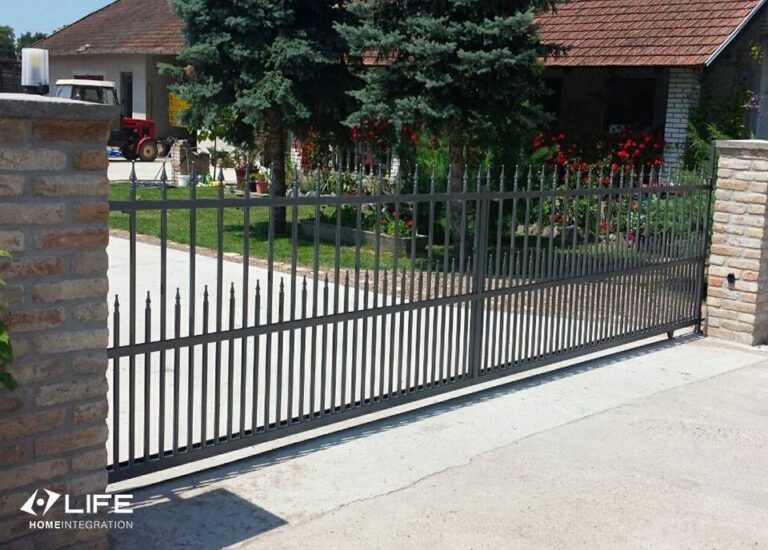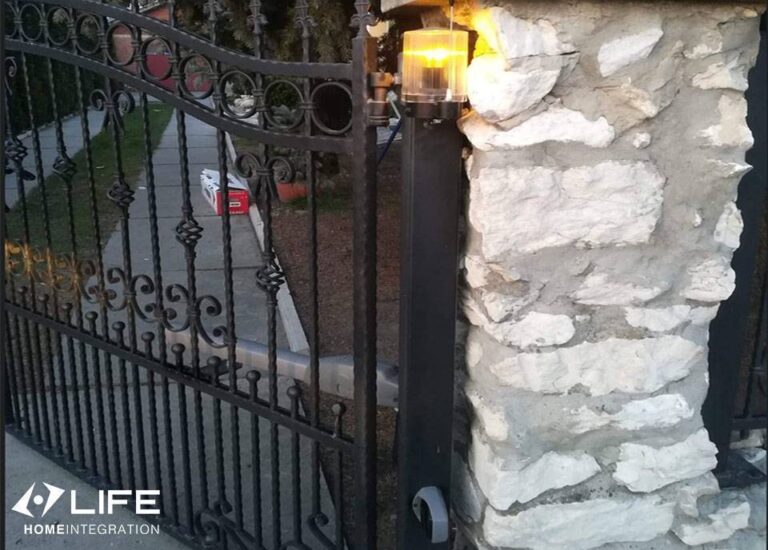Automatic gates and permits
You’ve decided to automate your gate but do not know what are the next steps? As always, LIFE Home Integration will not leave you unaided, but will guide you step-by-step to arrive at a solution.
What permits are required for installing an automatic gate?
The first question that often springs to mind concerns the permits required for installing a new automatic gate or a barrier.
Automating an existing gate is an intervention that does not require any certification to notify the commencement of the works. However, a new installation follows a different procedure: in this case, it is necessary to submit an Italian certified notice of commencement of works (SCIA) or an Italian notice of commencement of construction activities (DIA), depending on the type of intervention, to the technical department of the municipality in which the property is situated.
The safety regulations for automatic gates
Several years ago the European Union introduced regulations relative to the automation of gates, garage doors and barrier gates. From August 2002, the Italian National Unification Body (UNI) has diffused in Italian the European regulations on gate automation (EN 12453 and EN 12445) diffused as early as 2000.
A few details on these regulations are given below:
- EN 12453 “Industrial, commercial and garage doors and gates. Safety in use of power operated doors. Requirements and test methods”: this standard concerns the safety requirements for using the gate and lists all possible dangerous situations to be prevented. This standard on gate automation (and not only) is the actual reference standard concerning the safety of power-operated doors and gates, which specifies the installation requirements in line with the European directives.
- EN 12445 “Industrial, commercial and garage doors and gates. Safety in use of power operated doors. Test methods”: deals with the test methods to which gates must be subjected to verify their conformity to the requirements of the EN 12453 standard.
There are thus special procedures regarding the automation unit as an electrical device and the relevant installation techniques for preventing any risks linked to its use.
The role of the installer of the automatic gate
With regard to safety, the most important role is played by the installer, who is crucial also for making the automation unit safe and for assembling the automatic gate. The installer is responsible for:
- automating the gate while observing the safety requirements specified in the applicable regulations on gate automation.
- respecting the design and the guidelines provided by the manufacturers of the components of the automation unit to be installed, in a correct manner.
- verifying the correct operation of the automation unit.
- drawing up test reports and a file specifying all the details on the installation, on the wiring diagram and on the components used.
- drawing up the CE declaration of conformity, as required by the (Italian) Legislative Decree No. 37 of 2008 (handing a copy to the owner) and affixing a plate specifying: the identification data of the automation device, the installer’s data and the CE mark.
Permits and tax incentives for gate automation
Another important issue when making these types of interventions concerns the tax incentives that the Italian government has renewed also for 2020. Now let’s try to understand how an intervention on the home’s gate can fall under the works subject to the tax bonus.
Works for the mere maintenance of the gate do not qualify as deductible expenses. The installation of an opening/closing automation system, according to (Italian) Presidential Decree no. 380/01, is considered an extraordinary work, since it involves the implementation of technological systems.
Therefore, intervening with works that require the installation of a gate automation device can be regarded as an extraordinary maintenance intervention and thus subject to the tax bonus.
However, in order to avoid disappointments and misunderstandings, once the gate has been automated, contact the Italian Revenue Agency to get more information about whether the intervention is eligible for the tax bonus.
Nevertheless, the tax incentive for 2020, which is granted to whoever refurbishes, improves and electrifies an electric gate, consists in a 50% income tax (IRPEF) deduction on the expenses incurred.
Let’s make an example to better explain the idea: assuming we have spent a total of € 5,000 for the gate automation works, you can deduct € 250 each year from your income tax for 10 years (amounting to € 2,500, equal to 50% of the total expenses, that is, € 5,000).
Rules and responsibilities for installation and correct maintenance in condominiums
Condominium administrators often require explanations on this issue, so let’s try and make this topic a little more clear, since it has become increasingly regulated over the course of the years: the areas concerned include mechanical safety requirements, CE marking and the maintenance logbook.
Directive 2006/42/EC (Machinery Directive) states that the automatic gate (including any doors and barriers) must be considered as a machine for all intents and purposes. As such, it must comply with specific safety requirements, defined in the UNI 12453, UNI 12445 and UNI 12978 standards.
The Condominium Reform (Italian Law No. 220 of 2012) entrusts the condominium administrator with the responsibility for the correct installation of the gate. The administrator is also responsible for carrying out “acts of conservation for the rights pertaining to common parts of the building”, and thus for maintaining and upgrading existing systems.
What is the task of the condominium administrator? Which documents must be requested from the supplier?
First of all, it is important to contact a trusted installer. In case of a new installation, the company must deliver the following documents to the condominium administrator:
- the CE declaration of conformity of the system pursuant to the Machinery Directive and the related safety regulations.
- the use and maintenance manual.
- the maintenance logbook, which must be stored and updated after every intervention.
In case of an existing system, including those that are old or lacking any documentation, the administrator is entitled to submit the following requests to the installer:
- assess the suitability of all system components.
- verify the operation of the automation unit and of the ancillary components.
- measure the forces, draw up a report on the state of the system and indicate the necessary interventions for updating it in compliance with the relevant standard.
- issue the CE declaration of conformity.
- deliver the system’s maintenance logbook.
Another important issue to know is that maintenance is mandatory, and the Machinery Directive establishes a maintenance requirement with an annual frequency (or every six months, depending on the use of certain safety devices).
Also in this case the installer will be able to provide the correct information on the matter.
The administrator must therefore activate a scheduled maintenance service by signing the maintenance agreement.
With this detailed information we seek to respond to the most common queries regarding the automation of gates and garage doors, so that we can support our customers throughout the entire process, from the initial choice to the actual use, while ensuring constant and reliable support by LIFE Home Integration.

